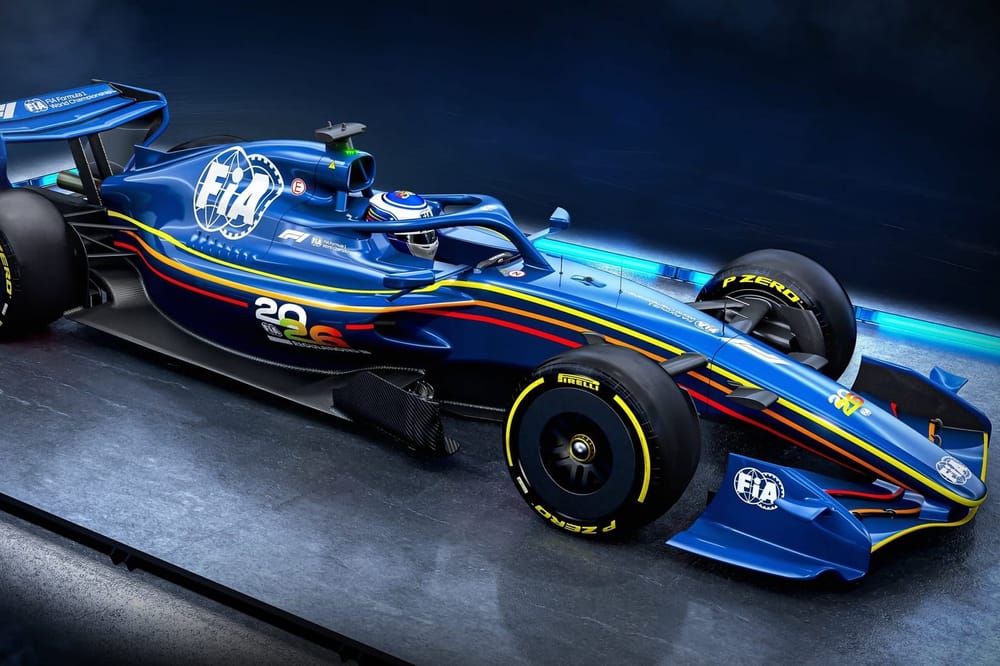F1 2026 Regulations Change
Powered by RedCircle

Formula 1 2026 Regulation Changes
Burke and Scott discussed Formula 1's 2026 regulations, focusing on the new cars' dimensions and power unit changes. The cars will be slightly smaller and lighter, with a 200mm reduction in wheelbase and 100mm narrowing in width, while the hybrid battery power will increase from 15% to 50%. They also discussed the potential for mandatory tire compound usage in F1 races to increase strategy complexity and improve tire management.
Formula 1 Aerodynamics and Innovation
Scott and Burke discussed the aerodynamic changes to Formula 1 cars, focusing on the new end plate design and its impact on air flow over the tire. They expressed concerns about the FIA potentially limiting design freedom, which could lead to uniform cars and reduced competition. Scott highlighted the importance of allowing teams to innovate within the rules, drawing parallels to past examples in NASCAR and IndyCar. They also discussed the role of bargeboards and rear wing end plates in managing air flow and potentially creating dirty air, with Scott predicting that teams would likely manipulate these elements to maintain a competitive edge.
Formula 1 Race Planning Discussion
Scott and Burke discussed the upcoming Formula 1 race in Austin, Texas, and Scott's potential attendance despite the high ticket prices. They also talked about the modular buildings used by F1 teams during races and Scott's involvement in a group that alerts him to F1 team building sales. The conversation included a brief break for music during future shows and a discussion about a video of an attached garage with a laser and fog machine.
Formula 1 2026 Regulation Changes
Scott and Burke discussed the new Formula 1 regulations for 2026, focusing on the movable triple-element rear and front wings, which will allow drivers to switch between low-drag and high-downforce configurations. They expressed concerns about the FIA's control over DRS and agreed that drivers should have more autonomy. The conversation also covered the introduction of bio-waste-derived fuel, the increased electrical power available to drivers, and the enhanced safety features of the new cars, including a stronger roll hoop and a two-stage front impact structure.
Formula 1's 2026 Power Split Revolution
Scott and Burke discussed the upcoming changes to Formula 1 cars in 2026, focusing on the new 50-50 power split between the engine and battery. They explored the implications of these changes, including the potential for drivers to run out of power mid-race and the need for completely rewritten driving styles. Burke expressed interest in seeing how the new system would affect racing, while Scott raised concerns about the environmental impact of battery production and the reliance on fossil fuels. They also discussed the potential for teams to gain an advantage through superior fuel management, despite the new power unit regulations.
Formula 1 2026 Power Unit Changes
The meeting discussed significant changes to Formula 1 in 2026, including a new power unit system that will require drivers to manage energy more strategically, with a ramp-down system for battery power and a manual override feature for overtaking. The discussion highlighted how these changes could affect team performance, with Scott Davis and Burke noting that teams that master the new technology could gain a significant advantage, while those that struggle might remain in the midfield for years. The conversation also touched on the introduction of 100% sustainable fuels and the potential impact on the broader automotive industry, though it was acknowledged that initial reliability issues are likely.
2024 Austin Race Review
Scott and Burke discussed the 2024 Austin race results, where Leclerc won, Sands was second, and Verstappen third, with Norris and Piastri in fourth and fifth. They reviewed the engine supplier changes for the 2024 season, including Renault for Alpine, Mercedes for Aston Martin, McLaren, and Williams, Ferrari for Ferrari and Haas, and Honda for Red Bull and AlphaTauri. Burke expressed interest in trying the new COTA track on a simulator due to its unique layout, and they discussed how teams' development strategies affect their performance at the end of the season.
COTA Track Challenges and Insights
Burke and Scott discussed the unique characteristics of the Circuit of the Americas (COTA) track, highlighting its significant elevation changes and challenging layout. They compared COTA's elevation to other famous tracks and noted its potential for unexpected race outcomes due to its demanding nature. Scott expressed excitement for the upcoming race and shared insights about the track's design and strategic importance. They also briefly touched on the logistical challenges faced by Formula 1 teams during the racing season, including the transportation of equipment across continents.
Formula 1 Logistics and Sustainability
Scott Davis shared fascinating insights into the logistical challenges of Formula 1 racing, highlighting how teams manage complex operations across continents. He explained how F1 teams use multiple sets of equipment, including chartered flights and ships, to support their global racing schedule, with each race requiring rapid setup and teardown of entire paddocks within tight timeframes. The discussion also touched on the environmental impact of these operations and F1's efforts to reduce carbon emissions, though the scheduling sometimes raises questions about efficiency.
